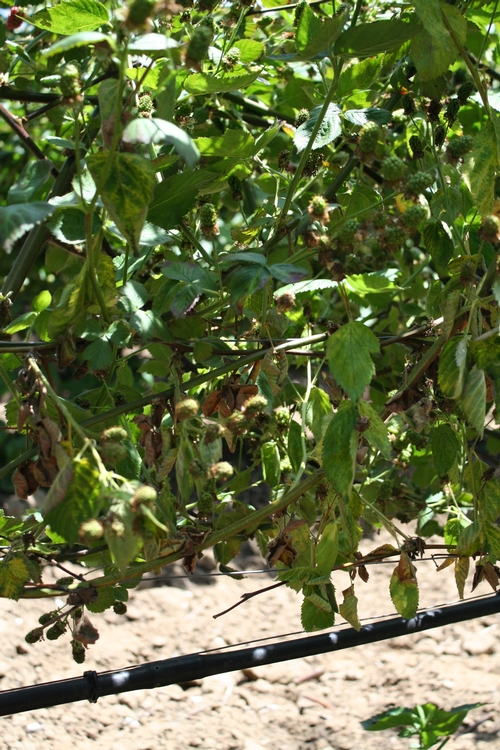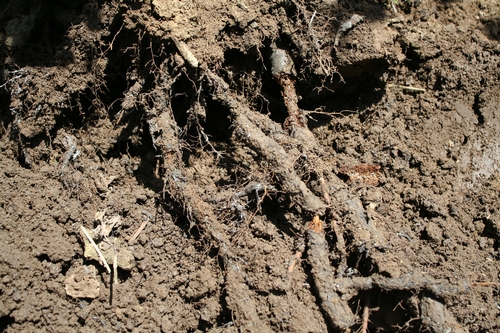We have had the misfortune of discovering Armillaria root rot on blackberry on the Central Coast. This is significant in that root rots such as those from species of Phythophthora or Verticillium are extremely rare in blackberries cultivated in this area.
Generally known as a pathogen of forest trees and orchard crops such as apples and avocados, this root rot is known by the common name “oak root fungus” and is caused by several different species of Armillaria fungus. The above ground symptoms of Armillaria root rot are those common to other root rots, that is to say wilt and stunting of canes and leaves (Photo 1 below). Below ground, roots in blackberry show obvious signs of rot frequently accompanied with whitish mycelial growth (Photo 2 below). While the literature also says this mycelium forms sheets and fans that was not the case in this particular situation. Importantly, the symptomatic plants are found in patches which slowly advance outward over time. In more advanced infections, one would also find black rootlike strands of 3-4 mm in diameter known as rhizomorphs. In the situation addressed here on the Central Coast, the infected areas were limited to rows and tended not to cross over into the next, so the paucity of root growth and moisture in the area between rows may be limiting to disease spread from row to row.
Armillaria infections of blackberry are a result of previously infected orchard plantings. Since this pathogen can persist for decades in infected stumps and other woody material, the history of a field should be of serious consideration for blackberry growers when looking at new ground to plant.
While it is undoubtedly a good idea to fumigate a piece of ground known to have been infected with Armillaria fungus, fumigation itself might not be enough because even the best fumigant may be hard put to penetrate infested stumps and other woody debris. With this in mind, to the extent possible, remove woody debris from a cleared orchard or forest prior to fumigation.
Once an infection is underway, the only way to address the problem is to limit the spread of the disease. This means removing symptomatic plants and as much of the roots as possible along with those plants immediately adjacent. No, this will not eradicate the fungus from the plantation but will serve to at least limit its spread through the field to other plants.
Attached Images:

Wilted blackberry from Armillaria. Leafs are sagging and losing color.

Blackberry root with Armillaria. Note that large roots are completely rotted, looking closely at center of photo one can see white mycelial strands.

Photo Courtesy Steven Koike, UCCE. Armillaria in culture.